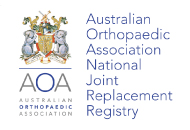Home
The Australian Orthopaedic Association National Joint Replacement Registry (AOANJRR) is an initiative of the Australian Orthopaedic Association (AOA). The AOANJRR was established in 1999 becoming fully national in mid 2002. The purpose of the AOANJRR is to improve and maintain the quality of care for individuals receiving joint replacement surgery. Information on hip, knee, shoulder, elbow, wrist, ankle and spinal disc replacement is collected from all hospitals in Australia undertaking joint replacement surgery.
The AOANJRR is funded by the Commonwealth Department of Health.
Director
Professor Stephen Graves
Deputy Directors
Professor Richard de Steiger
Mr Peter Lewis
Professor Ian Harris
Assistant Deputy Directors
Mr James Stoney
Mr William Donnelly
Manager
Ms Cindy Turner
General Enquiries:
Please direct all enquiries to the AOANJRR Manager
E: cturner@aoanjrr.org.au
T: +61 8 8128 4280
2018 Annual and Supplementary Reports
It is a pleasure to present the Australian Orthopaedic Association National Joint Registry (AOANJRR) 2018 Annual Report. The basic structure of the report is similar to last year. Previously reported analysis on the outcome of primary hip, knee and shoulder replacement has been updated and extended.
For this report, the analysis has been undertaken on 1,335,938 (593,803 hip, 717,334 knee and 44,801 shoulder) joint replacement procedures. Each year a number of new topics are carefully selected for more detailed analysis.
Each year the Report includes new information not previously published. This year the new chapters focus on the issue of elective joint replacement surgery for osteoarthritis in the elderly, an increasing number of patients aged ≥80 years are undergoing primary and revision hip and knee joint replacement. The purpose of the analysis is to provide further insight into the risk of mortality, revision and the approaches that can be taken to improve the outcome of joint replacement in group of patients.
As in previous years, in addition to the main report the Registry is publishing 11 supplementary reports, one of these is the lay summary which may be of particular interest to members of the community. The Registry also provides detailed analysis of all prostheses identified as having a higher than anticipated rate of revision.
All reports are available by clicking on the link above or via the ‘Publications' tab on the menu ribbon above.


